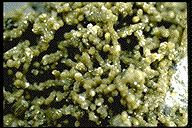

- Chemistry: NaNO3, Sodium Nitrate
- Class: Carbonates
- Subclass:
Nitrates - Uses: as a source of nitrate for fertilizer and as mineral specimens.
Specimens
Nitrates are similar to carbonates. The nitrogen is surrounded by three oxygens and forms a tight flat triangular NO3 ion group just like the carbonate triangular CO3 ion group. Thus nitrates are placed in the Carbonate Class of minerals.
But there are some differences. The nitrogen has a higher charge (+5) and is smaller than the carbon (+4) and thus the nitrogen holds the oxygens a lot closer and the nitrogen oxygen bonds are stronger. Also the overall charge of the nitrate ion group is only negative one (-1) compared to the carbonate's ion group's charge of negative two (-2). These differences show up in a greater difficulty in breaking apart the nitrate ion group as is usually an easy task for acids with the carbonate ion group, greater solubility and a much less diverse subclass of minerals.
Nitratine is most similar to the trigonal carbonates or those carbonates that belong to the Calcite Group, specifically magnesite, rhodochrosite, siderite, smithsonite, sphaerocobaltite and of course calcite and some rarer members. The structures of nitratine and the members of the Calcite Group are analogous and they therefore share many similar properties such as symmetry and crystal habits. The structures are so similar that nitratine in a laboratory can grow onto a crystal of calcite and essentially finish the crystal with nitratine instead calcite.
Another nitrate called niter, KNO3 (also known as "saltpeter") is more similar to the Aragonite Group of carbonate minerals. Nitratine is similar to its rarer cousin niter but is deliquescent and gives a different result in a flame test. The flame test is where a sample is burned in a flame and gives off a certain color. For niter the flame should be violet, an indicator of potassium, and for nitratine the flame should be yellow, an indicator of sodium.
Nitratine was an important source of nitrates for fertilizer and other chemical uses including fireworks. Nowadays, fixed nitrogen from the air has all but replaced nitratine as the main source of nitrogen. An interesting side note is that discarded specimens of nitratine were said to have been thrown into a garden and this is how the importance of nitrates in good plant growth was first discovered.
PHYSICAL CHARACTERISTICS:
- Color is white or gray, sometimes with tints of red-brown or yellow.
- Luster is vitreous.
- Transparency crystals are translucent to transparent.
- Crystal System is trigonal; bar 3 2/m
- Crystal Habits include masses and soil deposits in arid and desert regions. Crystals are rare, but when found are in the form of rhombohedrons similar to calcite's crystals.
- Cleavage is perfect in three directions forming rhombohedrons.
- Fracture is conchoidal.
- Hardness is 1.5 - 2.
- Specific Gravity is approximately 2.2 - 2.3 (below average)
- Streak is white.
- Associated Minerals gypsum, halite and other arid region minerals.
- Other Characteristics: Deliquescent, slightly sectile, very soluble in water and gives a yellow flame test result.
- Notable Occurrences include the Tarapaca and other northern Chile sites; Bolivia; Peru and Humboldt Co., Nevada, San Bernardino Co., California and New Mexico, USA.
- Best Field Indicators are crystal habit, flame test, solubility, deliquescence, hardness, occurrence and cleavage.








